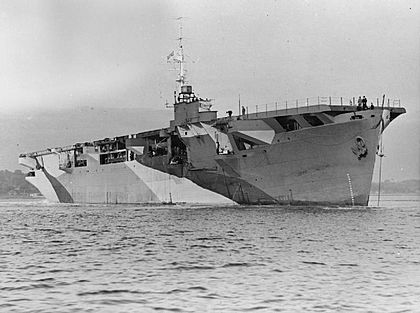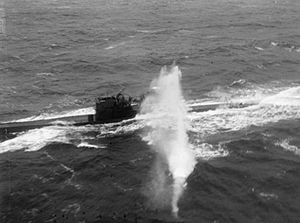Convoy JW 58 facts for kids
Convoy JW 58 was a very important group of ships that sailed together during World War II. It was an Arctic convoy. These convoys were sent from Great Britain by the Western Allies. Their mission was to help the Soviet Union.
Convoy JW 58 sailed in March 1944. It reached the northern ports of the Soviet Union in early April. Amazingly, all the ships in the convoy arrived safely. German U-boats (submarines) and aircraft attacked Convoy JW 58. But the convoy did not lose any ships. In fact, three German U-boats were destroyed. Six German aircraft were also shot down during these battles.
Contents
What Was Convoy JW 58?
Convoy JW 58 was a large group of merchant ships. These ships carried important supplies. They traveled together for safety. This convoy was one of the most successful ones during World War II. It showed how well the Allies could protect their ships.
Ships and Their Protectors
The convoy started with 47 merchant ships. They left Loch Ewe in Scotland on March 27, 1944. Three more ships joined from Iceland. These ships were coming from North America. One special ship was the US cruiser USS Milwaukee. This ship was being given to the Soviet navy. It was part of an agreement about captured Italian ships.
Who Was Protecting the Convoy?
Many warships protected Convoy JW 58. A "Close escort" force traveled right with the merchant ships. This group included destroyers and corvettes. It was led by Lt.Cdr Lambton in the destroyer HMS Westcott.
Two special escort aircraft carriers also traveled with the convoy. These were HMS Activity and HMS Tracker. They carried planes that could spot and attack U-boats.
An "Ocean escort" of 17 fleet destroyers also helped. This group was led by R.Adm. Frederick Dalrymple-Hamilton in the cruiser HMS Diadem. The very successful 2nd Support Group joined them too. This group was known for hunting submarines. It had five sloops and was led by Capt. Frederick Walker in HMS Starling.
Even more ships provided "Distant cover." These were powerful warships from the Home Fleet. They included the battleships HMS Duke of York and HMS Anson. The aircraft carrier HMS Victorious and the cruiser HMS Belfast were also there. This large force was led by Vice-Admiral Bruce Fraser. They were also busy with another mission called Operation Tungsten. This mission was to attack the German battleship Tirpitz.
Who Was the Enemy?
The German navy tried to stop the convoy. They used 16 U-boats. These submarines formed patrol lines named Blitz, Hammer, and Thor. By this time in the war, Germany's surface ships and air forces were not as strong. The Tirpitz battleship was still damaged. The German air force, the Luftwaffe, mostly did scouting missions. They tried to find the convoy and report its location.
The Journey and Battles
Convoy JW 58 left Scotland on March 27, 1944. It was first joined by local escort ships. On March 29, the convoy met ships from Iceland. These escorts then returned to their bases. The main escort forces took over.
First Encounters
On March 29, the ship Starling found a German U-boat. This U-boat, U-961, was not part of the German patrol lines. It was just passing through. But it was unlucky to meet the British ships. Starling and Magpie attacked it with depth charges. The U-boat was destroyed.
Big Fights and Victories
On March 31, Convoy JW 58 met the first German U-boat patrol line. For the next two days, the U-boats attacked the convoy 18 times. But none of the convoy ships were hit. Instead, three more U-boats were destroyed!
One U-boat, U-355, was destroyed by HMS Beagle and planes from the carrier Tracker. On April 2, HMS Keppel destroyed U-360. It used a special weapon called a hedgehog.
On April 3, a plane called a Swordfish from Activity attacked U-288. With help from other planes, a Martlet and a Avenger from Tracker, this U-boat was also destroyed.
On April 3, Soviet destroyers joined the convoy. On April 4, Convoy JW 58 arrived safely at Kola in the Soviet Union. There were no more attacks.
Why Was This Convoy Special?
Convoy JW 58 was a huge success for the Allies. All the merchant ships arrived safely. This meant important supplies reached the Soviet Union. Four German U-boats were destroyed. Six German scouting planes were also shot down.
This convoy was the last Arctic convoy for several months. The convoys stopped during the summer of 1944. This was because many naval forces were needed for Operation Neptune. This was the cover for the D-Day landings in Normandy, France. The Arctic convoys started again in August 1944 with Convoy JW 59.



